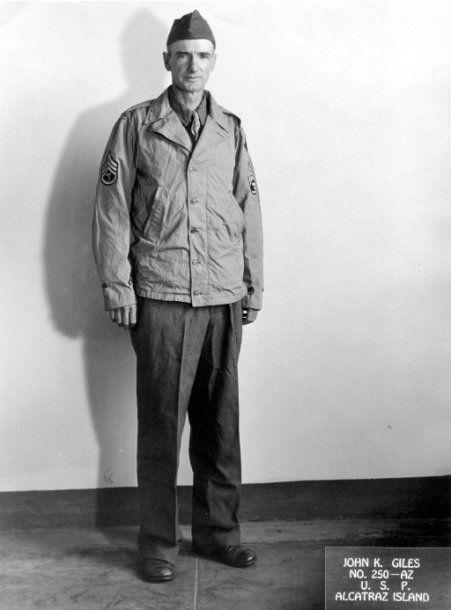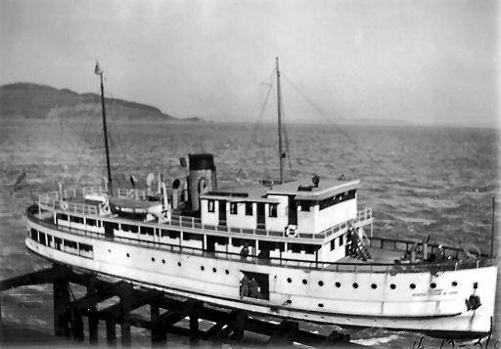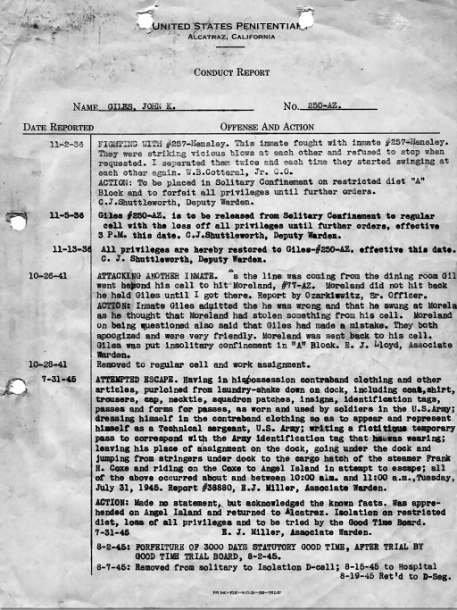In May of 1935, Giles and six accomplices made the ill-fated decision to rob the Denver and Rio Grande Mail Train in Salt Lake City. Reports show that the gang jumped onto the train, forcing the engineer to halt the locomotive and a few of the men then climbed into the cabin and held the engineer at gunpoint. They made their way back to the locked mail car and attempted to break a window to gain access without success. The gang fired randomly into the car through its windows, then threw in a large bottle of ammonia, attempting to force out the mail clerks with the pungent fumes. Their plan failed, as one of the mail clerks who was armed with a gun returned fire and forced the gang to retreat to an awaiting truck. Law officers quickly apprehended four of the men, along with Giles. Giles was sentenced to an additional twenty-eight years for the Federal crime of attempted mail robbery.
Giles arrived at McNeil Island Federal Penitentiary on June 17, 1935. Because of his escape record and the length of his sentence, he was transferred to Alcatraz on August 28, 1935. Giles seemed to adapt well to the routines at Alcatraz, though he was described in a 1943 progress report as follows: “he mixes little with other inmates and pretty well keeps to himself, being considered by some as odd.” Nevertheless, he was highly regarded by the correctional staff, and was generally considered to be friendly. Giles mother, who was now in her late 70’s, had moved to Los Angeles where one of his brothers was now residing so that she could be closer to her two sons. But Giles refused all visits from his mother, stating to the Warden that he didn’t want her to see him in prison. He seldom wrote to his family, and appeared to be leading a very quiet existence. His 1943 progress report states that Giles had been working as janitor at the dock and he was noted as an obedient and good worker, performing his job quietly and “without friction to others.” What officials failed to realize was that despite his calm disposition, Giles had been plotting a very elaborate escape plan for nearly a full decade.
Over the years, Giles had devised a system of monitoring the laundry deliveries made by an Army vessel dispatched from Fort McDowell, which was located across the bay on Angel Island. When the laundry arrived, the bales would be dumped onto a panning table and searched for contraband before being sent down to the Industries. Giles would carefully wait for a safe opportunity, and then, out of sight of both correctional officers and other inmates, he would conceal a garment or other potentially useful item in his jacket, and later hide it in a canvas bag under the dock. The dock security procedures were extremely tight, but there were frequent counts and searches of the inmates before they were allowed to return to the cellhouse. When the Army launch departed, Giles was always permitted to walk to the ramp area and sweep up, which provided the perfect opportunity to pull out his hidden bag and secrete his newly acquired items. Opportunities to lift items were scarce, and the process was tedious. It would take nearly ten years before he acquired all of the materials needed for his attempt.
On the morning of July 31, 1945, Giles was prepared for his escape, now having pieced together a complete Technical Sergeant’s uniform. At 10:10 a.m. the Army vessel General Frank M. Coxe pulled up next to the Alcatraz dock, parallel to a descending ramp. The soldiers exited onto the wharf and they were quickly counted, and then permitted to begin off-loading the laundry. Giles moved down the ramp and swiftly slipped on his improvised uniform. The uniform looked as though it fit Giles well, but it had a tousled and wrinkled appearance. Armed with only a flashlight, Giles boarded the vessel through a freight hatchway located just below deck. It is believed that Giles found his way to the boat’s lavatory and waited until the Coxe departed before venturing back out into a secluded area of the boat. Sergeant-at-Arms Corporal Paul Lorinz later stated that he was tipped off by deckhand Jerry Van Soest that a soldier was wandering below deck. Lorinz investigated and found Giles standing alone in a secluded area, and he asked him “Where are you going Sergeant?” Lorinz noted that Giles failed to look at him directly and responded by stating he was heading to “Fort McDowell.” When questioned further by Lorinz, Giles stated that he was a line repairman who was checking cables. He then pulled out a notebook and acted as though his was making notes. Lorinz made his way back up to the deck and reported that a soldier was onboard who had failed to present a pass.

John Giles would devise one of the most clever escape plans ever conceived at Alcatraz. Over the course of several years, he worked to collect and assemble a full Army uniform out of the Army laundry that was delivered to the dock area. This photo was taken immediately following his capture back on Alcatraz.

Army vessel General Frank M. Coxe. The open hatch door shows where Giles made his entry onto the vessel.

Back at Alcatraz, Giles’ absence had already been detected after he missed the routine departure count. Associate Warden E.J. Miller was contacted, and he and Phil Bergen quickly summoned the prison launch to rendezvous with the Army vessel, which was heading toward Angel Island. Warden Johnston was already on the phone making arrangements to have Giles apprehended once the Coxe arrived at Fort McDowell. Giles was completely unaware that his short taste of freedom had ended before it even began. As the Coxe arrived at Angel Island, Lieutenant Gordon L. Kilgore approached him asking to see his passes. As Giles disembarked from the launch, Miller and Bergen approached him and without any struggle, they handcuffed him and took him aboard the Warden Johnston to head back to the island. “You really felt kind of sorry for him once you saw the look on his face” Captain of the Guards Phil Bergen would later recall ...“He really should have won some sort of an award with that uniform.”
Giles was immediately returned to the island and was placed directly into the solitary strip cell. The FBI investigated the escape and put together an inventory of the items that had been found in Giles’s possession.
Warden James A. Johnston
United States Penitentiary
Alcatraz Island
San Francisco, California
Re: John Knight Giles
Dear Warden Johnston:
Pursuant to your request the following to your request the following personal effects which were found in the possession of the above captioned subject at the time of his apprehension at Angel Island on July 31, 1945 are being listed below:
One set of prison underwear.
One pair of prison socks.
One pair of brown prison shoes.
One regulation Army tie.
One pair of regulation U.S. Army pants labeled Kane Manufacturing Company, 1/19/43.
One Khaki Army overseas cap, red bordered #K-9699.
One regulation Army shirt bearing laundry mark #P2587.
One U.S. Army field jacket, size 38 L, bearing no identification marks, with Technical Sergeant’s chevrons on sleeve.
One white pouch containing small comb.
One navy blue pouch containing two flashlight bulbs, one Texaco touring map of San Francisco and the Bay Area, one State Auto Association map of Marin County, one small taped ball containing odd change.
One navy blue pouch containing shoulder patch U.S. Army, Pacific Coast Frontier Defense Sector.